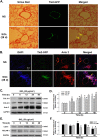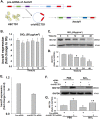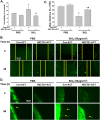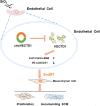circHECTD1 promotes the silica-induced pulmonary endothelial-mesenchymal transition via HECTD1
- PMID: 29540674
- PMCID: PMC5852113
- DOI: 10.1038/s41419-018-0432-1
circHECTD1 promotes the silica-induced pulmonary endothelial-mesenchymal transition via HECTD1
Abstract
Excessive proliferation and migration of fibroblasts contribute to pulmonary fibrosis in silicosis, and both epithelial cells and endothelial cells participate in the accumulation of fibroblasts via the epithelial-mesenchymal transition (EMT) and the endothelial-mesenchymal transition (EndMT), respectively. A mouse endothelial cell line (MML1) was exposed to silicon dioxide (SiO2, 50 μg/cm2), and immunofluorescence and western blot analyses were performed to evaluate levels of specific endothelial and mesenchymal markers and to elucidate the mechanisms by which SiO2 induces the EndMT. Functional changes were evaluated by analyzing cell migration and proliferation. The mRNA and circular RNA (circRNA) levels were measured using qPCR and fluorescent in situ hybridization (FISH). Lung tissue samples from both Tie2-GFP mice exposed to SiO2 and silicosis patients were applied to confirm the observations from in vitro experiments. Based on the results from the current study, SiO2 increased the expression of mesenchymal markers (type I collagen (COL1A1), type III collagen (COL3A1) and alpha smooth muscle actin (α-SMA/Acta2)) and decreased the expression of endothelial markers (vascular endothelial cadherin (VE-Cad/Cdh 5) and platelet endothelial cell adhesion molecule-1 (PECAM1)), indicating the occurrence of the EndMT in response to SiO2 exposure both in vivo and in vitro. SiO2 concomitantly increased circHECTD1 expression, which, in turn, inhibited HECTD1 protein expression. SiO2-induced increases in cell proliferation, migration, and changes in marker levels were restored by either a small interfering RNA (siRNA) targeting circHECTD1 or overexpression of HECTD1 via the CRISPR/Cas9 system, confirming the involvement of the circHECTD1/HECTD1 pathway in the EndMT. Moreover, tissue samples from SiO2-exposed mice and silicosis patients confirmed the EndMT and change in HECTD1 expression. Our findings reveal a potentially new function for the circHECTD1/HECTD1 pathway and suggest a possible mechanism of fibrosis in patients with pulmonary silicosis.
Conflict of interest statement
Conflict of interest
The authors declare that they have no conflict of interest.
Ethical approval
All participants provided written informed consent prior to participating in the study. The primary alveolar macrophages derived from human BALF were used in accordance with the approved guidelines from the Research and Development Committee of Nanjing Chest Hospital (2016-KL002-01), and all procedures were conducted in accordance with the Declaration of Helsinki.
Figures










Similar articles
-
circRNA Mediates Silica-Induced Macrophage Activation Via HECTD1/ZC3H12A-Dependent Ubiquitination.Theranostics. 2018 Jan 1;8(2):575-592. doi: 10.7150/thno.21648. eCollection 2018. Theranostics. 2018. PMID: 29290828 Free PMC article.
-
CircHECTD1 mediates pulmonary fibroblast activation via HECTD1.Ther Adv Chronic Dis. 2019 Nov 27;10:2040622319891558. doi: 10.1177/2040622319891558. eCollection 2019. Ther Adv Chronic Dis. 2019. PMID: 31832126 Free PMC article.
-
Inhibition of MARCO ameliorates silica-induced pulmonary fibrosis by regulating epithelial-mesenchymal transition.Toxicol Lett. 2019 Feb;301:64-72. doi: 10.1016/j.toxlet.2018.10.031. Epub 2018 Nov 2. Toxicol Lett. 2019. PMID: 30391304
-
Transcriptional regulation of endothelial-to-mesenchymal transition in cardiac fibrosis: role of myocardin-related transcription factor A and activating transcription factor 3.Can J Physiol Pharmacol. 2017 Oct;95(10):1263-1270. doi: 10.1139/cjpp-2016-0634. Epub 2017 Jul 7. Can J Physiol Pharmacol. 2017. PMID: 28686848 Review.
-
Endothelial-to-Mesenchymal Transition in Cardiovascular Pathophysiology.Int J Mol Sci. 2024 Jun 4;25(11):6180. doi: 10.3390/ijms25116180. Int J Mol Sci. 2024. PMID: 38892367 Free PMC article. Review.
Cited by
-
Circular RNAs: a rising star in respiratory diseases.Respir Res. 2019 Jan 5;20(1):3. doi: 10.1186/s12931-018-0962-1. Respir Res. 2019. PMID: 30611252 Free PMC article. Review.
-
Endothelial Cell Phenotype, a Major Determinant of Venous Thrombo-Inflammation.Front Cardiovasc Med. 2022 Apr 21;9:864735. doi: 10.3389/fcvm.2022.864735. eCollection 2022. Front Cardiovasc Med. 2022. PMID: 35528838 Free PMC article. Review.
-
CircRNA_0109291 regulates cell growth and migration in oral squamous cell carcinoma and its clinical significance.Iran J Basic Med Sci. 2018 Nov;21(11):1186-1191. doi: 10.22038/IJBMS.2018.30347.7313. Iran J Basic Med Sci. 2018. PMID: 30483394 Free PMC article.
-
circHECTD1 attenuates apoptosis of alveolar epithelial cells in acute lung injury.Lab Invest. 2022 Sep;102(9):945-956. doi: 10.1038/s41374-022-00781-z. Epub 2022 Apr 19. Lab Invest. 2022. PMID: 35440759
-
Single-cell analysis of salt-induced hypertensive mouse aortae reveals cellular heterogeneity and state changes.Exp Mol Med. 2021 Dec;53(12):1866-1876. doi: 10.1038/s12276-021-00704-w. Epub 2021 Dec 3. Exp Mol Med. 2021. PMID: 34862465 Free PMC article.
References
Publication types
MeSH terms
Substances
LinkOut - more resources
Full Text Sources
Other Literature Sources
Molecular Biology Databases
Miscellaneous

